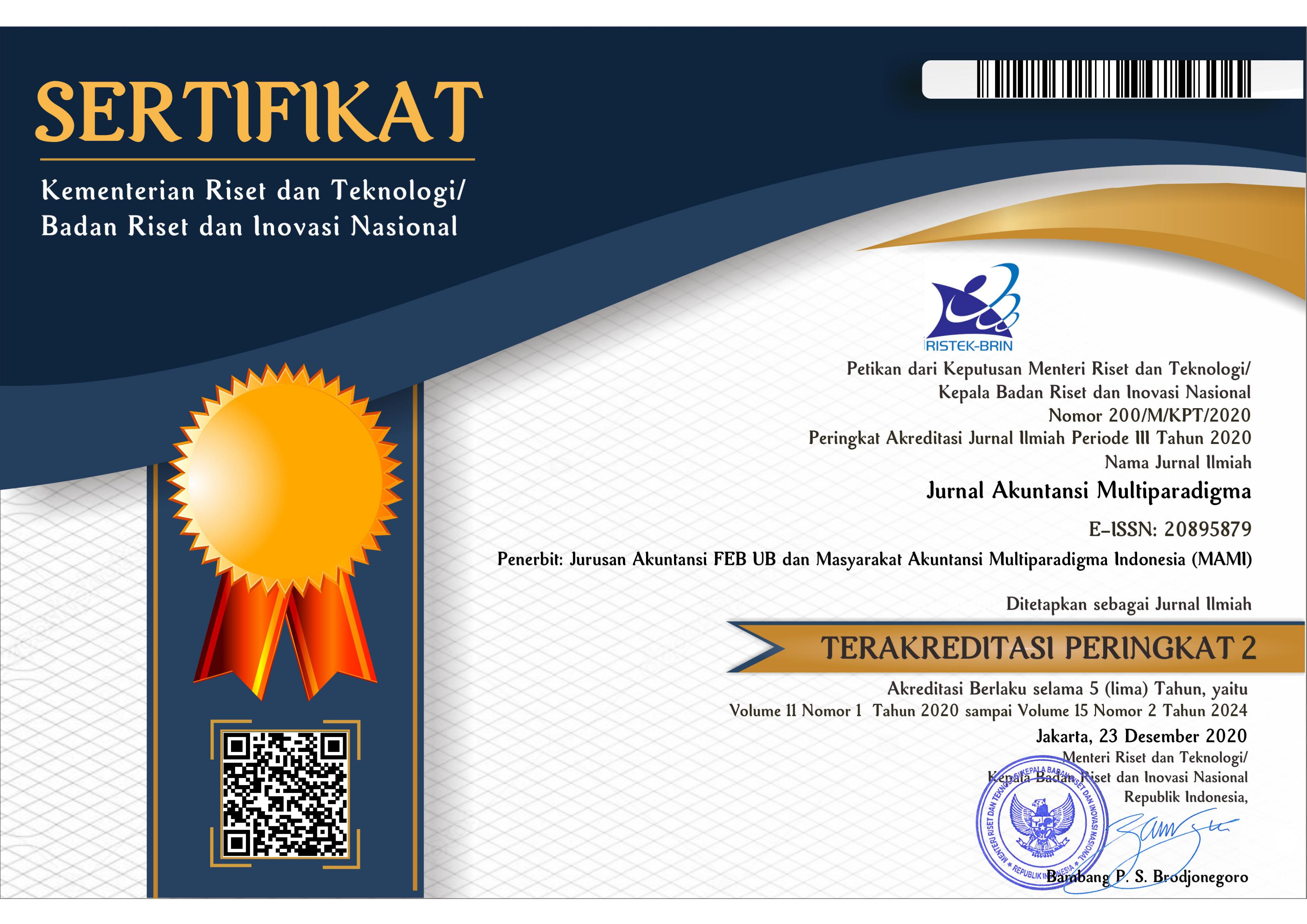DETERMINAN KINERJA BANK ISLAM
Abstract
Abstract: Determinant of Islamic Banks Performance. This study aims to examine the effect of strategic performance measurement system and interactive control on Islamic banking performance through capability. Data collection was done by mail survey to Islamic Bank in East Java and processed using Partial Least Square.. The study proves that interactive controls and strategic performance measurement systems are able to facilitate the organization. In addition, the capability contributes to improving organizational performance. These results become important so that information resources generated benefit. Nevertheless, the strategic performance measurement system has no effect on performance due to the different characteristics of Islamic banks making improvement in environmental change.
Keywords
Full Text:
PDFReferences
Abdullah, W. A. W., Percy, M., & Stewart, J. (2015). Determinants of Voluntary Corporate Governance Disclosure: Evidence from Islamic Banks in the Southeast Asian and the Gulf Cooperation Council Regions. Journal of Contemporary Accounting & Economics, 11(3), 262-279. https://doi.org/10.1016/j.jcae.2015.10.001
Abedifar, P., Hasan, I., & Tarazi, A. (2016). Finance Growth Nexus and Dual Banking Systems: Relative Importance of Islamic Banks. Journal of Economic Behavior & Organization, 132(S), 198-215. https://doi.org/10.1016/j.jebo.2016.03.005
Ahn, T. S., Hwang, I., & Kim, M. I. (2010). The Impact of Performance Measure Discriminability on Rate Incentives. Accounting Review, 85(2), 389–417. https://doi.org/10.2308/accr.2010.85.2.389
Ahyaruddin, M., & Akbar, R. (2016). The Relationship between the Use of a Performance Measurement System, Organizational Factors, Accountability, and the Performance of Public Sector Organizations. Journal of Indonesian Economy and Business, 31(1), 1–22.
Abdillah, W., & Hartono, J. (2015). Partial Least Square (PLS): Alternatif Structural Equation Modeling (SEM) dalam Penelitian Bisnis. Yogyakarta: Penerbit Andi.
Al-Gasaymeh, A. (2016). Bank Efficiency Determinant: Evidence from the Gulf Cooperation Council Countries. Research in International Business and Finance, 38, 214-223. https://doi.org/10.1016/j.ribaf.2016.04.018
Ali, M., & Azmi, W. (2016). Religion in the Boardroom and Its Impact on Islamic banks' Performance. Review of Financial Economics, 31, 83-88. https://doi.org/10.1016/j.rfe.2016.08.001
Ashraf, D., Rizwan, M. S., & L’Huillier, B. (2016). A Net Stable Funding Ratio for Islamic Banks and Its Impact on Financial Stability: An International Investigation. Journal of Financial Stability, 25, 47-57. https://doi.org/10.1016/j.jfs.2016.06.010
Asiaei, K. & Jusoh, R. (2017). Using A Robust Performance Measurement System to Illuminate Intellectual Capital. International Journal of Accounting Information Systems, 26, 1-19.
Bank Indonesia. (2013). Statistik Perbankan Syariah. Jakarta.
Basoglu, K. A., & Hess, T. J. (2014). Online Business Reporting: A Signaling Theory Perspective. Journal of Information Systems, 28(2), 67-101. https://doi.org/10.2308/isys-50780
Bisbe, J., & Malagueño, R. (2012). Using Strategic Performance Measurement Systems for Strategy Formulation: Does It Work in Dynamic Environments? Management Accounting Research, 23(4), 296–311. https://doi.org/10.1016/j.mar.2012.05.002
Boritz, J. E., Borthick, A. F., & Presslee, A. (2012). The Effect of Business Process Representation Type on Assessment of Business and Control Risks: Diagrams versus Narratives. Issues in Accounting Education, 27(4), 895-915. https://doi.org/10.2308/iace-50144
Capps, G., Koonce, L.,& Petroni, K. R. (2016). Natural Optimism in Financial Reporting: A State of Mind. Accounting Horizons, 30(1), 79-91. https://doi.org/10.2308/acch-51277
Charfeddine, L., Najah, A., & Teulon, F. (2016). Socially Responsible Investing and Islamic funds: New Perspectives for Portfolio Allocation. Research in International Business and Finance, 36, 351-361. https://doi.org/10.1016/j.ribaf.2015.09.031
Chen, C. X. (2015). Discussion of: Testing Strategy with Multiple Performance Measures: Evidence from a Balanced Scorecard at Store24. Journal of Management Accounting Research, 27(2), 67-73. https://doi.org/10.2308/jmar-51157
Cheng, M. M., Green, W. J., & Ko, J. C. W. (2015). The Impact of Strategic Relevance and Assurance of Sustainability Indicators on Investors' Decisions. AUDITING: A Journal of Practice & Theory, 34(1),131-162. https://doi.org/10.2308/ajpt-50738
Chenhall, R. H. (2005). Integrative Strategic Performance Measurement Systems, Strategic Alignment of Manufacturing, Learning and Strategic Outcomes: An Exploratory Study. Accounting, Organizations and Society, 30(5), 395–422. https://doi.org/10.1016/j.aos.2004.08.001
Crabtree, A. D., & DeBusk, G. K. (2008). The Effects of Adopting the Balanced Scorecard on Shareholder Returns. Advances in Accounting, 24(1), 8–15. https://doi.org/10.1016/j.adiac.2008.05.016
Direktorat Perbankan Syariah. (2012). Outlook Perbankan Syariah 2012. Jakarta.
Dossi, A., & Patelli, L. (2008). The Decision Influencing Use of Performance Measurement Systems in Relationships between Headquarters and Subsidiaries. Management Accounting Research, 19(2), 126–148. https://doi.org/10.1016/j.mar.2007.11.001
Fleming, D. M., Chow, C. W., & Chen, G. (2009). Strategy, Performance-Measurement Systems, and Performance: A Study of Chinese Firms. International Journal of Accounting, 44(3), 256–278. https://doi.org/10.1016/j.intacc.2009.06.004
Franceschini, F., Galetto, M., & Turina, E. (2013). Techniques for Impact Evaluation of Performance Measurement Systems. International Journal of Quality & Reliability Management, 30(2), 197-220.
Grafton, J., Lillis, A. M., & Widener, S. K. (2010). The Role of Performance Measurement and Evaluation in Building Organizational Capabilities and Performance. Accounting, Organizations and Society, 35(7), 689–706. https://doi.org/10.1016/j.aos.2010.07.004
Holzhacker, M., Krishnan, R., & Mahlendorf, M. D. (2015). Unraveling the Black Box of Cost Behavior: An Empirical Investigation of Risk Drivers, Managerial Resource Procurement, and Cost Elasticity. The Accounting Review, 90(6), 2305-2335. https://doi.org/10.2308/accr-51092
Hudayati, A., & Sofiah, M. A. (2011). Performance Measurement System, Organisational Learning and Business Unit Performance in Islamic Banks. Asian Journal of Accounting and Governance, 2, 1–13.
Ibrahim, M. H. (2015). Issues in Islamic Banking and Finance: Islamic Banks, Shari’ah-Compliant Investment and Sukuk. Pacific-Basin Finance Journal, 34, 185-191. https://doi.org/10.1016/j.pacfin.2015.06.002
Indjejikian, R. J., & Matĕjka, M. (2012). Accounting Decentralization and Performance Evaluation of Business Unit Managers. The Accounting Review, 87(1), 261-290. https://doi.org/10.2308/accr-10168
Johnson, E. N., Reckers, P. M. J., & Bartlett, G. D. (2014). Influences of Timeline and Perceived Strategy Effectiveness on Balanced Scorecard Performance Evaluation Judgments. Journal of Management Accounting Research, 26(1),165-184. https://doi.org/10.2308/jmar-50639
Journeault, M. (2016). The Influence of the Eco-Control Package on Environmental and Economic Performance: A Natural Resource-Based Approach. Journal of Management Accounting, 28(2), 149-178. https://doi.org/10.2308/jmar-51476
Kallunki, J.-P., Laitinen, E. K., & Silvola, H. (2011). Impact of Enterprise Resource Planning Systems on Management Control Systems and Firm Performance. International Journal of Accounting Information Systems, 12(1), 20–39. https://doi.org/10.1016/j.accinf.2010.02.001
Karlinsky, S. S., & Burton, H. A. (2016). Dis-Incorporation of the American Business Model. The ATA Journal of Legal Tax Research, 14(1),1-19. https://doi.org/10.2308/jltr-51208
Khan, M. M. (2013). Developing a Conceptual Framework to Appraise the Corporate Social Responsibility Performance of Islamic Banking and Finance Institutions. Accounting and the Public Interest, 13(1), 191-207. https://doi.org/10.2308/apin-10375
Kolehmainen, K. (2010). Dynamic Strategic Performance Measurement Systems: Balancing Empowerment and Alignment. Long Range Planning, 43(4), 527–554. https://doi.org/10.1016/j.lrp.2009.11.001
Lee, J., Elbashir, M. Z., Mahama, H., & Sutton, S. G. (2014). Enablers of Top Management Team Support for Integrated Management Control Systems Innovations. International Journal of Accounting Information Systems, 15(1), 1–25. https://doi.org/10.1016/j.accinf.2013.07.001
Lee, M. T., & Widener, S. K. (2016). The Performance Effects of Using Business Intelligence Systems for Exploitation and Exploration Learning. Journal of Information Systems, 30(3), 1-31. https://doi.org/10.2308/isys-51298
Louhichi, A., & Boujelbene, Y. (2016). Credit Risk, Managerial Behaviour and Macroeconomic Equilibrium within Dual Banking Systems: Interest-free vs Interest-based Banking Industries. Research in International Business and Finance, 38, 104-121. https://doi.org/10.1016/j.ribaf.2016.03.014
Lengnick-Hall, M. L., Lengnick-Hall, C. A., & Rigsbee, C. M. (2013). Strategic Human Resource Management and Supply Chain Orientation. Human Resource Management Review, 23(4), 366–377. https://doi.org/10.1016/j.hrmr.2012.07.002
Maswadeh, S. N. (2015). An Evaluation of SMEs Satisfaction Toward Jordanian Islamic Banks Service Quality. Procedia Economics and Finance, 23, 86-94. https://doi.org/10.1016/S2212-5671(15)00463-3
Meutia, I. (2010). The Concept of Social Responsibility Disclosures for Islamic Banks based on Shari’ah Enterprise Theory. Jurnal Akuntansi Multiparadigma, 1(3), 361-374.
Mollah, S., & Zaman, M. (2015). Shari’ah Supervision, Corporate Governance and Performance: Conventional vs Islamic Banks. Journal of Banking & Finance, 58, 418-435. https://doi.org/10.1016/j.jbankfin.2015.04.030
Muchlis, S., & Sukirman, A. S. (2016). Implementasi Maqashid Syariah dalam Corporate Social Responsibility di PT. Bank Muamalat Indonesia. Jurnal Akuntansi Multiparadigma, 7(1), 120-130. http://dx.doi.org/10.18202/jamal.2016.04.7011
Pepinsky, T. B. (2013). Development, Social Change, and Islamic Finance in Contemporary Indonesia. World Development, 41(1), 157–167. https://doi.org/10.1016/j.worlddev.2012.06.007
Primarisanti, H. (2015). Factors Influencing the Success of Performance Measurement: Evidence From Local Government. Journal of Indonesian Economy and Business, 30(1), 56–71.
Ramlan, H., & Adnan, M. S. (2016). The Profitability of Islamic and Conventional Bank: Case Study in Malaysia. Procedia Economics and Finance, 35, 359-367. https://doi.org/10.1016/S2212-5671(16)00044-7
Rashid, A., & Jabeen, S. (2016). Analyzing Performance Determinants: Conventional versus Islamic Banks in Pakistan. Borsa Istanbul Review, 16(2), 92-107. https://doi.org/10.1016/j.bir.2016.03.002
Runyan, R., Droge, C., & Swinney, J. (2008). Entrepreneurial Orientation versus Small Business Orientation: What are Their Relationships to Firm Performance? Journal of Small Business Management, 46(4), 567-588.
Santos, M. F., Lucianetti, L., & Bourne, M. (2012). Contemporary Performance Measurement Systems: A Review of Their Consequences and A Framework for Research. Management Accounting Research, 23(2), 79-119.
Sargent, C. S. (2013). Find It, Fix It, and Thrive: The Impact of Insisting on Proficiency in Prerequisite Knowledge in Intermediate Accounting. Issues in Accounting Education, 28(3), 581-597. https://doi.org/10.2308/iace-50456
Schindehutte, M., Morris, M. H., & Kocak, A. (2008). Understanding Market‐driving Behavior: The Role of Entrepreneurship. Journal of Small Business Management, 46(1), 4-26.
Siregar, S. (2016). Apakah Distribusi Bagi Hasil Cash Basis Berkeadilan Bagi Deposan Bank Syariah? Jurnal Akuntansi Multiparadigma, 7(1), 81-90. http://dx.doi.org/10.18202/jamal.2016.04.7007
Siswanti, I. (2016). Implementasi Good Corporate Governance pada Kinerja Bank Syariah. Jurnal Akuntansi Multiparadigma, 7(2), 307-321. http://dx.doi.org/10.18202/jamal.2016.08.7023
Spekl, R. F., & Verbeeten, F. H. M. (2014). The Use of Performance Measurement Systems in the Public Sector: Effects on Performance. Management Accounting Research, 25(2), 131–146. https://doi.org/10.1016/j.mar.2013.07.004
Sorwar, G., Pappas, V., Pereira, J., & Nurullah, M. (2016). To Debt or Not to Debt: Are Islamic Banks Less Risky than Conventional Banks? Journal of Economic Behavior & Organization, 132 (S), 113-126. https://doi.org/10.1016/j.jebo.2016.10.012
Tajeddini, K. (2010). Effect of Customer Orientation and Entrepreneurial Orientation on Innovativeness: Evidence from the Hotel Industry in Switzerland. Tourism Management, 31(2), 221-231
Wanke, P., Azad, M. A. K., Barros, C. P., & Hassan, M. K. (2016). Predicting Efficiency in Islamic Banks: An Integrated Multicriteria Decision Making (MCDM) Approach. Journal of International Financial Markets, Institutions and Money, 45, 126-141. https://doi.org/10.1016/j.intfin.2016.07.004
Widener, S. K. (2007). An Empirical Analysis of the Levers of Control Framework. Accounting, Organizations and Society, 32(7–8), 757–788. https://doi.org/10.1016/j.aos.2007.01.001
Wijaya, A. H. C., & Akbar, R. (2013). The Influence of Information, Organizational Objectives and Targets, and External Pressure Towards The Adoption of Performance Measurement System in Public Sector. Journal of Indonesian Economy and Business, 28(1), 62–83.
Wood, D. A. (2016). Comparing the Publication Process in Accounting, Economics, Finance, Management, Marketing, Psychology, and the Natural Sciences. Accounting Horizons, 30(3), 341-361. https://doi.org/10.2308/acch-51443
Xu, B., & Huang, Z. (2016). Information Traffic and Information Effectiveness. Journal of Emerging Technologies in Accounting, 13(2), 21-36. https://doi.org/10.2308/jeta-51548
DOI: http://dx.doi.org/10.18202/jamal.2017.08.7060
Refbacks
- There are currently no refbacks.
Copyright (c) 2017 Mitha Endah Aprilia, Rosidi, Erwin Saraswati

This work is licensed under a Creative Commons Attribution-NonCommercial 4.0 International License.

















